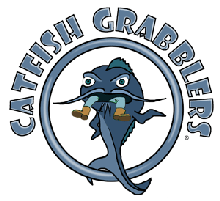by Richard Simms
posted June 26, 2003
 Photo by Richard Simms Fostana Jenkins and her husband wrestle a monster blue catfish to shore that they caught barehanded from Watts Bar Lake. |
Some people call it "grabblin'." Most however,
call it "crazy!"
It is the basically Southern art of finding and capturing
catfish with bare hands, just you and a fish in hand-to-jaw
combat.
I have the scarred fingers to prove it. Last weekend area expert
grabblers, Marty Jenkins, his wife Fostana, Robby Davis and
Harold Eaton escorted me on a grabbling expedition on Watts Bar
Lake. It was duel-purpose adventure as we also videotaped a
story for the Tennessee Wild Side television program -- in other
words, there is video evidence of what some might find
unbelievable.
"Oh, he's in there," exclaimed Marty Jenkins as he felt under
the first concrete boat ramp.
The group started grabbling in 1982 on a whim. Jenkins said “I’m
not sure if I found the first fish or if that fish found me. I
started feeling under rocks and something grabbed hold of my
hand. I jerked it out of there and hollered. Robby was laughing
so hard he couldn’t stand up. He said, 'What is it? Go back and
get it.’ I told him I didn’t know what it was but I’m not
sticking my hand back in that hole. He hopped out of the boat
and he ended up grabblin’ our first catfish.”
Davis said, “once you’re bit (pun intended) it’s an addiction.”
For ten years they grabbled the natural rock shelves of Watts
Bar. And then one day two little kids came by with no fishing
rods, but they had two monster blue cats.
Marty said, "they told us, 'yea, we use to roll around them old
rocks but now the only we places we go are boat ramps.”
“It was pretty humbling having two kids explain a better way to
do what you’ve been doing ten years," added Davis. But soon they
went and found one of the numerous concrete boat ramps on Watts
Bar. As Davis said, “What is a boat ramp? It’s a huge rock.”
They learned quickly that it's perfect habitat for monster
catfish to create beds for spawning. Mid-May to mid-July is
prime time.
Back to Jenkins who is probing beneath the concrete with a
hooked metal pole. The hook is not sharp, instead it has a
rounded point.
“Some of these holes are eight and ten feet across," said
Jenkins. "We only use the hook to corral the fish back to us. Or
sometimes they’ll actually grab the hook and we can pull them
out to us where we can get a hand on them.”
Or sometimes the fish come to you. Like any parent protecting
it's young, they can be aggressive. Especially the big blue
catfish.
"We call it a 'catfish shakin’ your hand," said Marty. "Some of
those handshakes get pretty rough."
"You can’t hardly describe the feeling of a big catfish grabbing
hold of you,” said Fostana. She's a petite woman, but proudly
carries the marks of catfish battles on her arms.
The first written reference to grabbling I can find via the
Internet comes from a trader-historian named James Adair. In the
18th century he wrote of southern Indians “diving under the rock
where the catfish lie to shelter, offering their hand as bait to
a fish that immediately seize it with the greatest violence.
Then is the time for the diver to seize the voracious fish by
his tender parts, hath a sharp struggle with it against the
crevices of the rock, and at last brings it safe ashore.”
That "safe ashore" part is questionable. The video produced by
the Jenkins' and their friends carries a large disclaimer
reading, "there is an inherent risk of having bodily parts
injured or mangled if you are crazy enough to engage in the
sport of catfish grabblin’. You may also drown yourself, so
grabble at your own risk.”
I can attest to that. I observed as the group grabbled two
catfish, both in the 40-pound class. Then Jenkins said, "Okay
Richard. It's your turn."
I was nervous, however my pride wouldn't let me say "no."
Jenkins asked, "do you want a pair of gloves?"
Hesitantly I told him, "no. If I'm going to do this, I want the
scars to prove it."
The waters of Watts Bar are excessively high right now. Often
you can grabble some holes without putting your head under the
water. Right now that's impossible however. In deep water,
grabblers must take a breath, dive down and work underwater as
long as your breath holds out.
You almost always work in teams, one person using arms and legs
to "block" the hole while the other grabbler tries to lure or
coax the monster cat within reach. Sometimes it happens quickly,
sometimes it can take 30 minutes or even more. It's work.
Jenkins and I dove down several times, a couple of times I felt
the slimy-skinned catfish but could never find a hand-hold. And
then finally Jenkins coaxed the big flathead catfish out
head-first. I felt my bare hand slide around his toothy lower
jaw, grabbed and pulled.
Of course it pulled back and the underwater fight began as the
huge fish fought to stay where it was. My lungs were absorbing
the last few molecules of oxygen they had left when we finally
felt the fish start to slide out from beneath the concrete slab.
When I hit the surface the 40-pound giant began to roll like
alligator. Jenkins screamed, "hug him Richard, hug him!"
One hand still in his jaw, I wrapped the monster in a bear hug,
struggled to shore and fell exhausted in the grass, the huge
flathead flopping beside me.
The grabbling group hollered and laughed at me. I examined my
fingers that looked like they had been sand papered, flexed my
nearly-sprained wrist, and exclaimed breathlessly, "you call
this fun?"
They do, and they do it well. In the course of a few hours, they
repeated the scenario nine times -- all the fish were 30 pounds
plus. And of course a few got away without getting grabbled.
Don't worry that they're depleting the population of big
spawning catfish. They're in it for the thrills, returning every
fish to the water to spawn and get grabbled on another day.
The last hole I grabbled with Jenkins was especially deep. About
six feet down and too deep for me to stand up. Nervous and
excited, my breath wouldn't last long, decreasing on each
successive dive. Finally Jenkins coaxed the fish within arms
reach. We both grabbed a handful of catfish and struggled to the
surface. The huge fish thrashed and rolled in the deep water. We
had him by the jaw, but without our feet on solid ground, there
was no question that the fish was in control of the situation.
Eaton leapt from a nearby dock to come help, but before he
arrived my survival instincts kicked in. I released the fish and
struggled to where my feet could once again touch the concrete
ramp. Meanwhile Jenkins gasped for air, but refused to release
his vice-like grip on the thrashing monster. he wrapped his legs
around it to help control the violent thrashing and twisting.
Eaton, a bear of a man himself, grabbed Jenkins and the fish,
hauled them to shallower water and we all struggled to dry land.
Jenkins gathered his breath and his wits, looked at me with a
big wide grin and said, "that's grabblin."
To view Pictures and video links for this article please click the link below and you will be directed to Richard Simms article at Chattanooga.com: Grabble This!
 Photo by Richard Simms One reason indians and pioneers used to grabble is because it was an excellent way to put a lot of meat on the table quickly. The Catfish Grabblers show why. |


